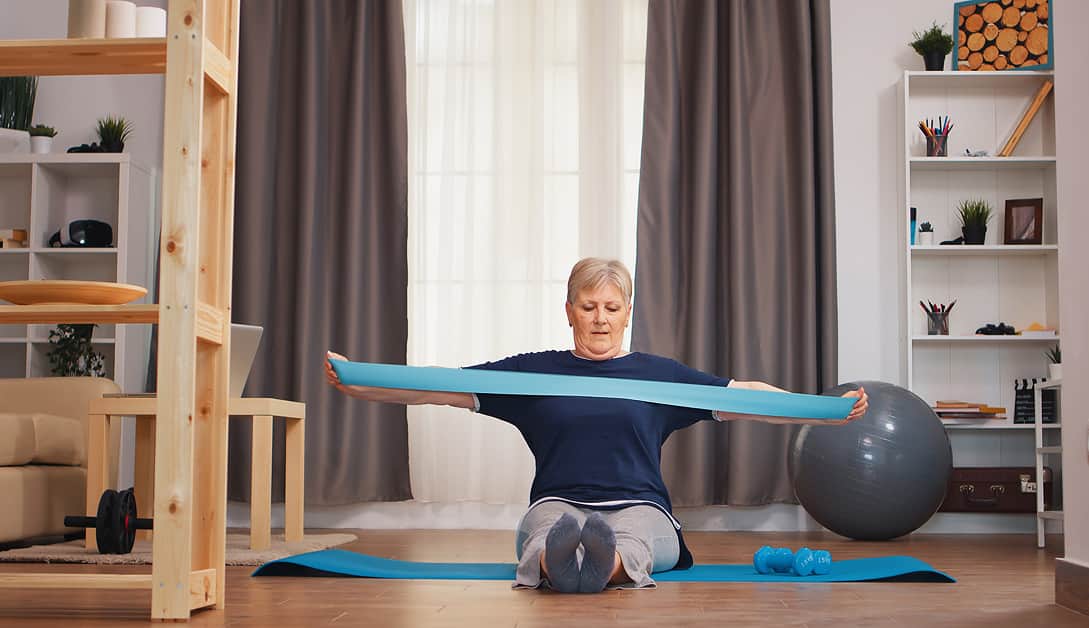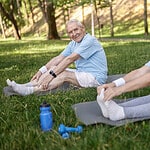Introduction
Resistance bands – an awesome way to get stronger and more limber knee muscles. More resistance than regular exercises! Plus, they’re portable, low-cost and come in different levels of resistance.
Get started with these four knee muscle exercises:
Benefits of Resistance Band Exercises
Resistance bands are a great way to work out your lower body. They are easy to take with you, and you don’t need much space. Plus, you can quickly and safely build your leg and hip muscles.
The American Council on Exercise (ACE) says that using bands requires more muscles than free weights or machines. This helps strengthen your joints and improve balance. Plus, the resistance of the bands increases circulation which helps nourish your muscles and joints. It also gives you better flexibility and range of motion.
Lastly, using bands during exercise is an efficient way to slim down. They challenge more muscle tissue than non-resistant exercises.
So if you want to improve balance, increase endurance and stimulate weight loss – get some resistance bands today!
Exercise #1: Lateral Band Walks
Resistance bands are awesome for building knee muscles. A great exercise to try is lateral band walks. Loop the band around your feet and secure it tightly. Stand tall, with your feet shoulder-width apart. Then, slowly walk sideways, keeping your feet touching the band. You want to keep tension on the band, taking small steps. This exercise targets specific areas of your knees, giving them an awesome workout!
How to do Lateral Band Walks
Lateral Band Walks are an inexpensive and effective exercise to strengthen knee and hip muscles. Stronger knee muscles help with a healthy range of motion, avoid injuries, and improve running performance.
To do:
- Stand with feet slightly wider than hip distance. Put band just above knees for added resistance.
- Step out sideways with one foot, then bring other foot to meet it. Keep good posture, with tension on the band at all times. Make each step small and controlled.
- Keep stepping sideways and applying even pressure across both legs, until a comfortable stopping point near max lateral distance outward or when form deteriorates.
- Pause couple seconds before repeating on other side, or alternate back and forth until reps are complete. Do 5-15 reps in 2-3 sets, depending on fitness level/goals.
Benefits of Lateral Band Walks
Lateral Band Walks are awesome for strengthening knee muscles, improving balance, and increasing stability. These exercises tone and strengthen your knees and build balance. Not only can this exercise improve performance on the field, but it also helps with everyday movements like walking and picking things up.
Doing this exercise means more than just stronger muscles. It helps promote better knee joint health, which is essential for pain-free movement. During this exercise, you’re strengthening the muscles and ligaments around your knee joint, giving it support, stability, and increased flexibility. It can also reduce strain on your joints when performing other exercises or daily movements that require weight bearing or support.
Regular lateral band walks do more than that. They:
- Increase stability in the hip joint.
- Improve agility when making quick turns while running.
- Generate extra force against ground contact when pushing off.
- Help prevent injuries such as ACL tears and hamstring pulls.
Exercise #2: Banded Squats
Go for squats with resistance bands if you’re looking to target and fortify your knee muscles. These bands offer a greater challenge than regular squats, and can help build strength and stability in the knees. Furthermore, this exercise engages many other muscles, aiding strength development all around.
To start, attach the band above the knee, around your lower upper legs.
How to do Banded Squats
Banded squats, an exercise that tones and builds lower body strength, uses a band to keep pressure on your joints for better support. This is a great way to challenge yourself and add resistance to your lower body routine!
Here’s how to do it:
- Stand with feet hip-width apart, the band around legs above knees, and hold one end in each hand with arms straight out at shoulder level.
- Sit back as if into an imaginary chair, keeping spine long and chest upright, and weight evenly distributed.
- Squat as low as possible, or until hips are at knee level, then return to starting point by pushing through heels.
- Aim for 3 sets of 10-12 reps, with 30 seconds rest between sets.
Benefits of Banded Squats
Banded squats are a great way to boost knee muscles, particularly those around the ACL (anterior cruciate ligament) and MCL (medial cruciate ligament). Bands help you target the desired muscle groups for maximum benefit. This exercise is especially recommended for those who have recently had an injury weakening their knee area or those wanting to improve leg strength and stability.
The advantages of banded squats are manifold. These include:
- improved muscular strength;
- stability in knees;
- flexibility in all joints;
- balance and coordination;
- better performance during physical activities;
- reduced risk of injury due to weak leg muscles; and
- better control of movements.
You can achieve better performance in physical activities by making it simpler to move in any direction quickly.
In addition, banded squats reduce the risk of further injury by developing stronger stabilizing muscles around the knee joint. They are ideal for gyms and home exercisers who don’t have access to weights!
Exercise #3: Banded Leg Curls
The banded leg curl is fab for strengthening your knees. It targets your hamstrings, glutes and knee joint. Plus, it helps stabilize the knee and improves balance. You can use any size resistance band. It’s perfect for warming up or strength exercises.
Here’s how to do the banded leg curl!
How to do Banded Leg Curls
Band leg curls are an amazing way to target the muscles that support your knee. Adding resistance to hamstring curls activates small parts that don’t get much attention with body weight exercises.
Before starting, don’t forget to warm up. Warming up properly helps prevent muscle tears and reduces the risk of injury. 5-10 minutes of jogging, jumping rope, running stairs, or dynamic stretching is recommended.
Instructions:
- Get a band with medium tension and loop it around both feet.
- Lie down with your hips and knees bent 90 degrees, over your chest. Keep knees in line with your hips.
- Engage core muscles and extend legs, maintaining control until fully extended, but not locked.
- Flex both legs, keeping them in line with your shoulders.
- Repeat 10-15 times or until fatigue.
- Rest for 30 seconds then repeat 4 sets.
Benefits of Banded Leg Curls
Banded leg curls are an awesome resistance exercise. They target the knee muscles – hamstrings and gluteus maximus – and help prevent injuries, improve range of motion and build strength.
The great thing is that they are adjustable. Pick a tougher band for a more difficult workout. This lets you work out at any level you feel comfortable with.
Banded leg curls also help increase core strength and stability in the lower body. They require both top and bottom legs to coordinate, strengthening balance and stability. Plus, they are low impact, perfect for those with knee pain who can’t do weighted exercises.
Athletes benefit too! Those who play sports like basketball, soccer or lacrosse reduce their likelihood of knee injuries from running and jumping by doing these routinely with resistance bands.
Exercise #4: Banded Hip Thrusts
Banded Hip Thrusts: an exercise to boost your knee muscles! This activity works your core and hip area, plus it helps with balance and stability. Adding a Resistance Band increases difficulty and intensity for stronger knees.
How to do the Banded Hip Thrusts? Let’s have a look!
How to do Banded Hip Thrusts
Banded hip thrusts are a great way to build lower body strength. They target the glutes, hamstrings, quads and core.
Start by using a resistance band. Place it around feet or ankles – tension should be light to moderate.
- Lie flat on your back, feet on the floor and knees bent.
- Pull the band up towards the hips while keeping tension.
- Push through the heels and lift the hips towards the ceiling.
- Hold for a second or two, then slowly lower.
Do 8-15 reps, 1-3 sets. To increase the challenge, use a tighter band or wear it higher. To make it easier, use a lighter band or no band at all.
Remember proper form – chest proud and core engaged. Keep shoulders away from ears and everything in “tall” alignment. Knees need to stay over ankles, and ankles over toes.
Benefits of Banded Hip Thrusts
Banded hip thrusts build strength in the hip flexors, glutes, and quads. It does this by using resistance from a band to extend the hips. This helps balance the muscles and increases strength and stability in the lower body. It also engages more of the inner and outer hip muscles than traditional weight training.
Banded hip thrusts build a stronger posterior chain, improve posture, and help performance in running, cycling, and swimming. It also stops hip injuries from everyday activities like lifting and carrying or going up stairs.
In conclusion, banded hip thrusts are an easy and effective way to get strong hips and avoid injury or overworking.
Conclusion
To sum up, it’s important to have strong knee muscles to avoid injury and perform better. Resistance band exercises are a great way to do this.
Some of the options include:
- Squats
- Quad/Hamstring kickbacks
- Single leg curls
- Lunges
These exercises target the knee muscles effectively. Go slowly and focus on using the correct muscles for best results. With practice, you can gradually get stronger and more agile.
Frequently Asked Questions
Q1. What are some resistance band exercises that I can do to build stronger knee muscles?
A1. Some exercises you can do with a resistance band to build stronger knee muscles include lateral band walks, banded squats, banded forward and backward lunges, and monster walks.
Q2. How many repetitions should I do for each exercise?
A2. It is recommended to do 3 sets of 10-15 repetitions of each exercise. It is important to start slowly and increase the repetitions as you become stronger.
Q3. What kind of resistance band should I use?
A3. It is recommended to use a medium-resistance band. You can adjust the resistance by changing the thickness of the band or by tying a knot to make the band shorter.





